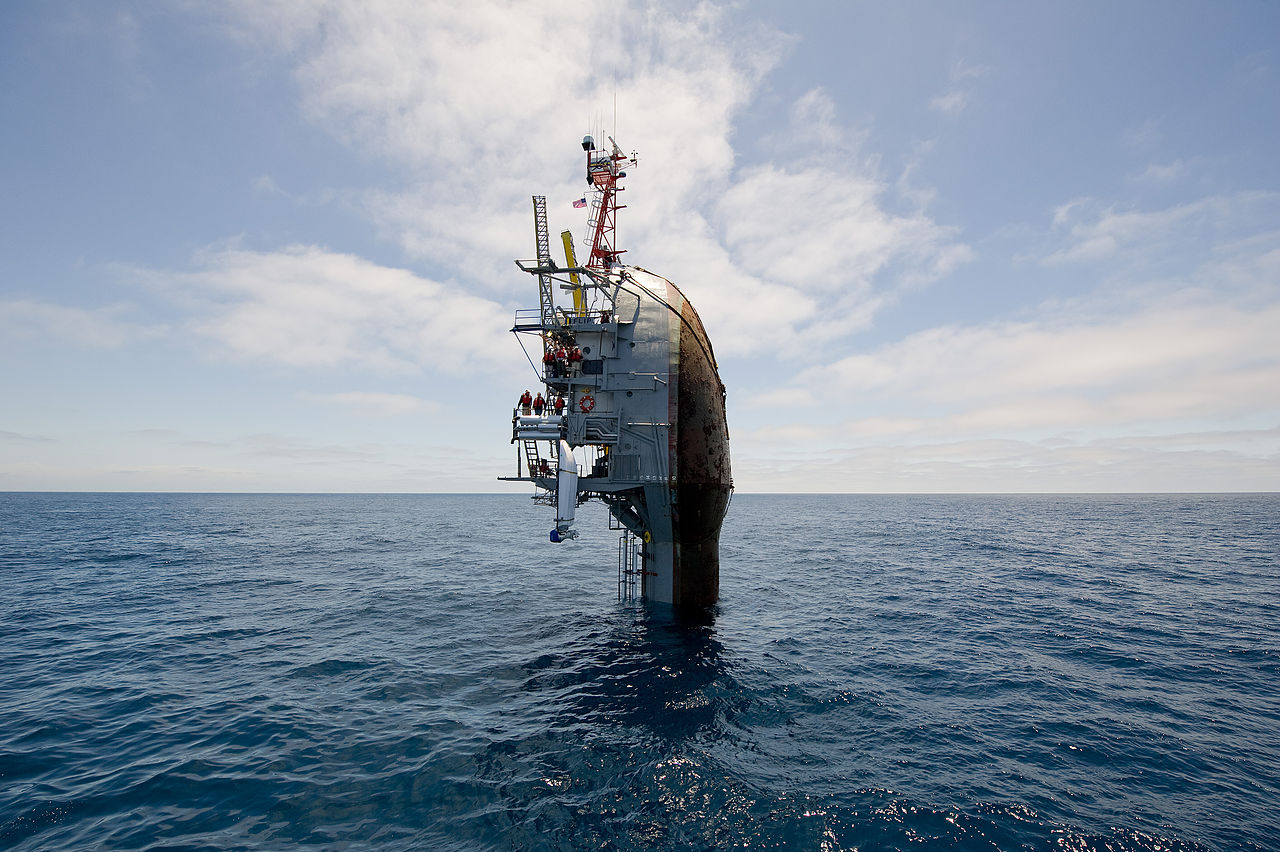© 2005 All Rights Reserved. Do not distribute or repurpose this work without written permission from the copyright holder(s).
Printed from https://www.damninteresting.com/curio/the-boat-designed-to-capsize/

The US Navy has a nifty oceangoing research ship which performs a controlled capsize in order to perform scientific tests. It’s called the FLoating Instrument Platform (FLIP), and it was conceived and developed by the Marine Physical Laboratory (MPL) at the Scripps Institution of Oceanography, University of California, San Diego.
FLIP is 355 feet long, and is technically not a ship, but rather a specialized, manned buoy with a 300 foot draft. When in horizontal traveling mode, the long, hollow ballast area trails behind. When it reaches the desired location, the “tail” is flooded until the nose sticks straight up into the air, taking about twenty-eight minutes to reach vertical position. Even in stormy conditions, it is as stable as a fencepost, because most of its length lies in the untroubled waters beneath the waves.
From the FLIP homepage:
During the flip, everyone stands on the outside decks. As FLIP flips, these decks slowly become bulkheads. (This is the name sailors use for walls.) The crew step onto decks that were, only moments before, bulkheads. Inside, decks have become bulkheads; bulkheads have become decks or overheads (ceilings).
Some of FLIP’s furnishings are built so they can rotate to a new position as FLIP flips. Other equipment must be unbolted and moved. Some things, like tables in the galley (kitchen) and sinks in the washroom, are built twice so one is always in the correct position.
FLIP was originally built to measure effects on the environment caused by long range sound propagation, but it has also been used for research in geophysics, meteorology, physical oceanography, non-acoustic anti-submarine warfare, and in laser propagation experiments.
Update, August 2023: FLIP has been officially retired after over 50 years of service.
© 2005 All Rights Reserved. Do not distribute or repurpose this work without written permission from the copyright holder(s).
Printed from https://www.damninteresting.com/curio/the-boat-designed-to-capsize/
Since you enjoyed our work enough to print it out, and read it clear to the end, would you consider donating a few dollars at https://www.damninteresting.com/donate ?
I saw a piece on news/documentary piece on this some months ago. Quite spectacular to see do its thing–everything really does flip.
A visit on this ship and the actual experience of the FLIP in “flip mode” would be a truly fascinating experience.
Can anyone fill me in on the “effects on the environment caused by long range sound propagation” ?
Can anyone fill me in on the “effects on the environment caused by long range sound propagation” ?”
I think that the effect of soundwaves on the bottom of the sea. Some sounds are thought to create landslides under the water kinda like when people yell on a mountain-top and create a landslide or avalanche. I think some sounds also confuse some animals like dolphins who locate each other by “singing” underwater. If you saw that dolphin who came up the Themes in London they think it’s because he thought the sounds of the port were his other dolphin friends.
Why bulkheads? Thats not even an abbreviation. Also it seems to me some of the best minds of our generation are being wasted on thinking up witty acronyms.
sorry to break it to ya dude, but bulkhead is a really old ass sailor term.
It was a whale that came up the Thames.
so you think they give tours of this ship?
I’ve seen a display on one of these at the Scripps marine institute museum in north San Deigo. I think the institute actually has one, or at least the use of one.
THoM said: “sorry to break it to ya dude, but bulkhead is a really old ass sailor term.”
That still doesn’t answer the question of why they call it that. Maybe there’s a damn interesting story behind it?
rev.felix said: “That still doesn’t answer the question of why they call it that. Maybe there’s a damn interesting story behind it?”
According to wiki.
The word bulki meant “cargo” in Old Norse. Sometime in the 15th century sailors and builders realized that walls within a vessel would prevent cargo from shifting during passage. In shipbuilding, any vertical panel was called a “head.” So walls installed abeam (side-to-side) in a vessel’s hull were called “bulkheads.” Now, by extension, the term applies to every vertical panel aboard a ship, except for the hull itself.
The term was later applied to other vehicles, such as trams, aircraft or spacecraft, as well as to containers, such as fuel tanks. In some of these cases bulkheads are airtight to prevent air leakage or the spread of a fire.
Other kinds of partition elements within a ship are decks and deckheads.
Damn that’s sweet. Talk about needing to “batten down the hatches.”
Flooding the ship seems easy.. but how do they drain the water out?
I work as a civilian employee for the Navy command that has custody of FLIP. I believe it’s still in use now and then. I’ve seen it from a distance of maybe two or three hundred feet, and was pretty excited to see it. I remember reading about it as a kid.
It’s almost certainly viewable on Google Earth or the photo option of Google Maps. If you go to the San Diego, California area and then zero in on the north/south Point Loma peninsula, take a look along the eastern shore of the peninsula. At some point after some up and down scrolling, you should be able to see it.
There is a boat that is designed to look like a yacht that is sinking… but this one takes the cake.
Note to self: Finished.